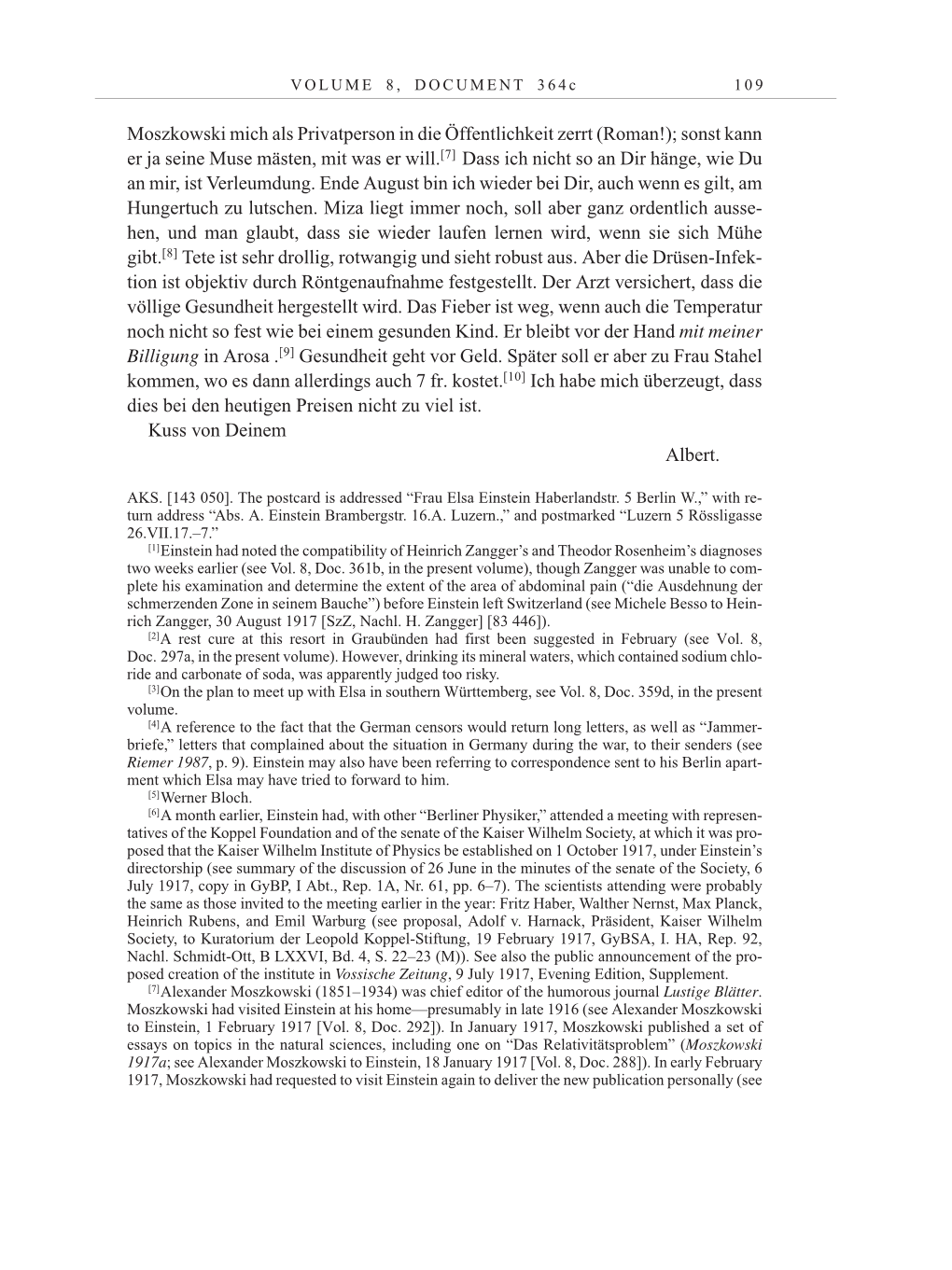V O L U M E 8 , D O C U M E N T 3 6 4 c 1 0 9
Moszkowski mich als Privatperson in die Öffentlichkeit zerrt (Roman!); sonst kann
er ja seine Muse mästen, mit was er
will.[7]
Dass ich nicht so an Dir hänge, wie Du
an mir, ist Verleumdung. Ende August bin ich wieder bei Dir, auch wenn es gilt, am
Hungertuch zu lutschen. Miza liegt immer noch, soll aber ganz ordentlich ausse-
hen, und man glaubt, dass sie wieder laufen lernen wird, wenn sie sich Mühe
gibt.[8]
Tete ist sehr drollig, rotwangig und sieht robust aus. Aber die Drüsen-Infek-
tion ist objektiv durch Röntgenaufnahme festgestellt. Der Arzt versichert, dass die
völlige Gesundheit hergestellt wird. Das Fieber ist weg, wenn auch die Temperatur
noch nicht so fest wie bei einem gesunden Kind. Er bleibt vor der Hand mit meiner
Billigung in Arosa
.[9]
Gesundheit geht vor Geld. Später soll er aber zu Frau Stahel
kommen, wo es dann allerdings auch 7 fr.
kostet.[10]
Ich habe mich überzeugt, dass
dies bei den heutigen Preisen nicht zu viel ist.
Kuss von Deinem
Albert.
AKS. [143 050]. The postcard is addressed “Frau Elsa Einstein Haberlandstr. 5 Berlin W.,” with re-
turn address “Abs. A. Einstein Brambergstr. 16.A. Luzern.,” and postmarked “Luzern 5 Rössligasse
26.VII.17.–7.”
[1]Einstein had noted the compatibility of Heinrich Zangger’s and Theodor Rosenheim’s diagnoses
two weeks earlier (see Vol. 8, Doc. 361b, in the present volume), though Zangger was unable to com-
plete his examination and determine the extent of the area of abdominal pain (“die Ausdehnung der
schmerzenden Zone in seinem Bauche”) before Einstein left Switzerland (see Michele Besso to Hein-
rich Zangger, 30 August 1917 [SzZ, Nachl. H. Zangger] [83 446]).
[2]A rest cure at this resort in Graubünden had first been suggested in February (see Vol. 8,
Doc. 297a, in the present volume). However, drinking its mineral waters, which contained sodium chlo-
ride and carbonate of soda, was apparently judged too risky.
[3]On the plan to meet up with Elsa in southern Württemberg, see Vol. 8, Doc. 359d, in the present
volume.
[4]A reference to the fact that the German censors would return long letters, as well as “Jammer-
briefe,” letters that complained about the situation in Germany during the war, to their senders (see
Riemer 1987, p. 9). Einstein may also have been referring to correspondence sent to his Berlin apart-
ment which Elsa may have tried to forward to him.
[5]Werner Bloch.
[6]A month earlier, Einstein had, with other “Berliner Physiker,” attended a meeting with represen-
tatives of the Koppel Foundation and of the senate of the Kaiser Wilhelm Society, at which it was pro-
posed that the Kaiser Wilhelm Institute of Physics be established on 1 October 1917, under Einstein’s
directorship (see summary of the discussion of 26 June in the minutes of the senate of the Society, 6
July 1917, copy in GyBP, I Abt., Rep. 1A, Nr. 61, pp. 6–7). The scientists attending were probably
the same as those invited to the meeting earlier in the year: Fritz Haber, Walther Nernst, Max Planck,
Heinrich Rubens, and Emil Warburg (see proposal, Adolf v. Harnack, Präsident, Kaiser Wilhelm
Society, to Kuratorium der Leopold Koppel-Stiftung, 19 February 1917, GyBSA, I. HA, Rep. 92,
Nachl. Schmidt-Ott, B LXXVI, Bd. 4, S. 22–23 (M)). See also the public announcement of the pro-
posed creation of the institute in Vossische Zeitung, 9 July 1917, Evening Edition, Supplement.
[7]Alexander Moszkowski (1851–1934) was chief editor of the humorous journal Lustige Blätter.
Moszkowski had visited Einstein at his home—presumably in late 1916 (see Alexander Moszkowski
to Einstein, 1 February 1917 [Vol. 8, Doc. 292]). In January 1917, Moszkowski published a set of
essays on topics in the natural sciences, including one on “Das Relativitätsproblem” (Moszkowski
1917a; see Alexander Moszkowski to Einstein, 18 January 1917 [Vol. 8, Doc. 288]). In early February
1917, Moszkowski had requested to visit Einstein again to deliver the new publication personally (see
